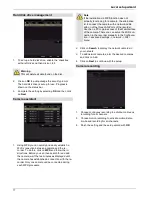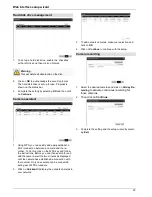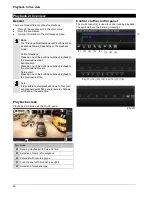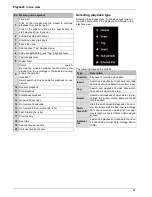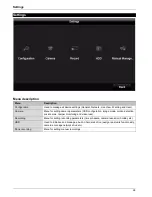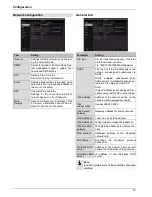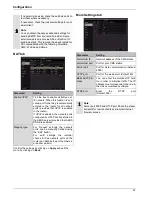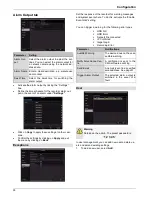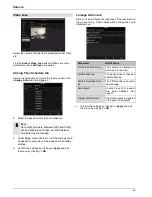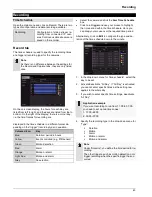
Configuration
General network
It is essential that the network settings are correct if you
•
want to control the device and monitor remotely via
your browser.
Note
Please read the following general instructions be-
fore setting up the device.
A network is the connection of at least two network-com-
patible devices.
Transmission methods:
•
wired networks (e.g. CAT5 cable)
•
wireless networks (Wi-Fi)
•
other transmission types (Powerline)
All systems have significant similarities but are different
in various ways.
Terms
Below there is an overview of terms related to using the
device on networks.
Parameter
Setting
IP address
An IP address is the unique address of
a network device on a network.
It must only appear once on a network.
Certain IP address ranges are reserved
for public networks, such as the internet.
Private ad-
dress range
E.g. 10.0.0.0–10.255.255.255
Subnet mask 255.0.0.0
172.16.0.0–172.31.255.255
Subnet mask 255.255.0.0
192.168.0.0–192.168.255.255
Subnet mask 255.255.255.0
Subnet mask
A subnet mask is a bit mask that is used
to make decisions and assignments
during routing.
The standard subnet mask on home
networks is 255.255.255.0.
Gateway
A gateway is a network device that al-
lows all other network devices to access
the internet.
It can be, for example, the computer to
which the DSL modem is connected or,
most frequently, the router or access
point on the network.
Parameter
Setting
Name
server
The name server, also known as the DNS
(Domain Name Server), is responsible for
assigning a unique IP address to a web ad-
dress or URL (e.g. www.google.de).
When a domain is entered into a browser,
the DNS searches for the corresponding IP
address of the server and forwards the
query on to it.
The IP of the provider’s DNS can be en-
tered here. However, it is often sufficient to
select the IP of the gateway. This then for-
wards the queries independently to the
provider DNS.
DHCP
The DHCP server automatically assigns
the IP address, subnet mask, gateway and
name server to a network device.
DHCPs are available in current routers.
The DHCP service must be specially set
and activated (see the relevant manual for
more information).
Note:
When using fixed IP addresses together
with a DHCP server, you should ensure
that the fixed IP addresses are outside of
the addresses assigned by DHCP to avoid
problems occurring.
Port
A port is an interface that enables different
programs to communicate. Certain ports
are fixed (23: Telnet, 21: FTP), whilst oth-
ers can be freely selected. Ports are rele-
vant for various applications, e.g. for exter-
nal access to the device via a browser.
MAC ad-
dress
The MAC address (Media Access Control
address or Ethernet ID) is the specific
hardware address of the network adapter.
It is used for the unique identification of the
device on a computer network.
Network layout
The device must be physically connected to the network
with a CAT5 cable; see Connections on page10.
Note
Please follow the instructions and notes for the
network devices.
Several switches/routers/access points can be con-
nected to one another. Firewalls and other security soft-
ware may have a negative effect on the network.
Warning
When using a router, the network clients, and
therefore the recorder, are “connected” to the in-
ternet and vice versa.
You should make sure that you take protective
measures, such as using a firewall, changing your
password and changing the port, to prevent unau-
thorised external access.
29



